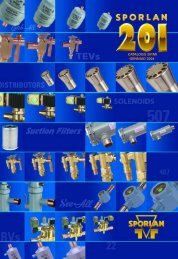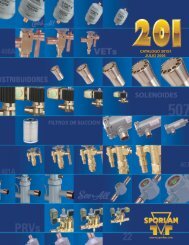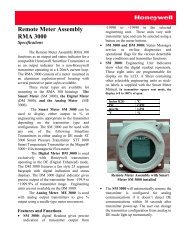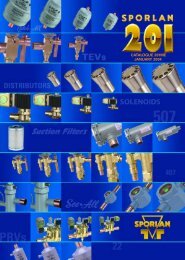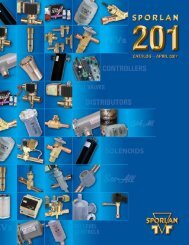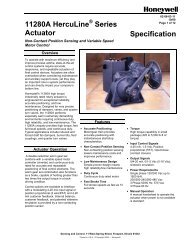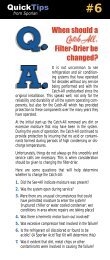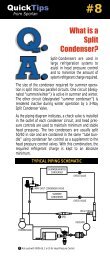catalog 717.qxd
catalog 717.qxd
catalog 717.qxd
Create successful ePaper yourself
Turn your PDF publications into a flip-book with our unique Google optimized e-Paper software.
CATALOG<br />
Page 3<br />
Thermostatic Expansion Valves<br />
The same features and design principles found in thermostatic<br />
expansion valves for Refrigerants – 12, 22, 134a, and 502 are<br />
also incorporated in Sporlan thermostatic expansion valves for<br />
Ammonia. They have proven their value and acceptance in the<br />
Industry for over 65 years.<br />
nozzle. If the discharge tube is not removed from the valve, the<br />
combination of the discharge tube and distributor nozzle may<br />
create an excessive pressure drop resulting in a substantial loss<br />
of TEV capacity. Refer to page 8 for further information on<br />
ammonia distributors.<br />
Refrigerant 717 (Ammonia) Applications<br />
Thermostatic expansion valves for ammonia applications<br />
require special design considerations due to the erosive effects<br />
of ammonia vapor. For this type of application, Sporlan has<br />
developed the Types D and A thermostatic expansion valves.<br />
Like other components of ammonia systems, the Types D and<br />
A valves are made from steel and steel alloys. The materials<br />
used in the manufacture of these valves are listed on pages 4<br />
and 5.<br />
With ammonia systems, the formation of flash vapor at the<br />
expansion valve port causes valve seat erosion or wire drawing<br />
to occur. This effect is further aggravated by high velocity<br />
ammonia mixed with dirt or scale passing through the port of<br />
the expansion valve. Fortunately, seat erosion can be minimized<br />
and valve life extended if the following steps are taken:<br />
1. Maintain vapor-free liquid at the TEV inlet at all times.<br />
2. Maintain clean ammonia through effective filtration.<br />
3. Reduce the velocity of the ammonia through the TEV<br />
port by reducing the pressure drop across the port.<br />
Step 1 can be accomplished through proper system design.<br />
Liquid line vapor is prevented by adequately sizing liquid lines<br />
and providing sufficient subcooling.<br />
Step 2 can be assured with the use of a Sporlan Catch-All ®<br />
Filter-Drier. This filter-drier is an effective scale trap when<br />
used on ammonia systems. For further information on the use<br />
of the Catch-All Filter-Drier with ammonia systems, refer to<br />
Bulletin 40-10 and page 15 of this bulletin.<br />
Step 3 can be accomplished with the use of a removable discharge<br />
tube or the nozzle of a refrigerant distributor. These<br />
components reduce the velocity and pressure drop at the<br />
expansion valve port by introducing a restriction or added<br />
pressure drop in the valve outlet passage.<br />
The nominal 75 and 100 ton Type A valves do not employ a<br />
discharge tube since their valve outlets are designed to serve as<br />
a secondary orifice to reduce pressure drop across the valve<br />
port.<br />
Thermostatic Charges for Ammonia Valves<br />
Thermostatic charges C, Z, and L are available for the Type D<br />
thermostatic expansion valve. The Type L thermostatic charge<br />
is the only charge available for the Type A valve.<br />
The Types C and Z thermostatic charges provide operating<br />
advantages for systems that cycle in response to a suction<br />
pressure switch or thermostat. These charges are also recommended<br />
for systems using a small capacity compressor. The<br />
table below lists the recommended temperature range for each<br />
charge.<br />
THERMOSTATIC<br />
CHARGE<br />
EVAPORATOR<br />
TEMPERATURE<br />
° F<br />
C 40° to 0°<br />
Z 0° to -20°<br />
For applications at evaporator temperature below -20°F, consult<br />
Sporlan Valve Company, Washington, Missouri 63090.<br />
Cold storage plants often have large centralized ammonia systems<br />
consisting of many evaporators connected to one or more<br />
large compressors. This makes for fairly stable suction pressures.<br />
The Sporlan type L charge responds more quickly to<br />
changes in bulb temperature allowing for a quicker pull-down<br />
of the conditioned space temperature. Therefore, for large<br />
ammonia systems consisting of multiple evaporators, the Type<br />
L charge is recommended.<br />
The removable discharge tube is threaded into the outlet of the<br />
Type D valves, and the nominal 20, 30, and 50 ton Type A<br />
valves. The discharge tube is the principle difference between<br />
ammonia TEVs and TEVs used with other refrigerants.<br />
Discharge tube sizes are listed in the Type D and A valve specifications<br />
on pages 4 and 5.<br />
The discharge tube in the outlet passage must be removed when<br />
the TEV is combined with a Sporlan ammonia distributor and




